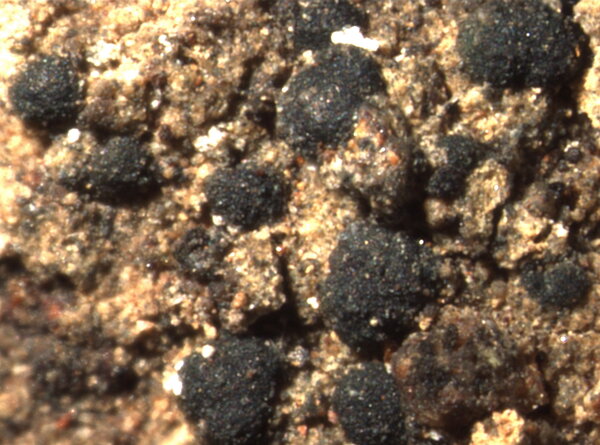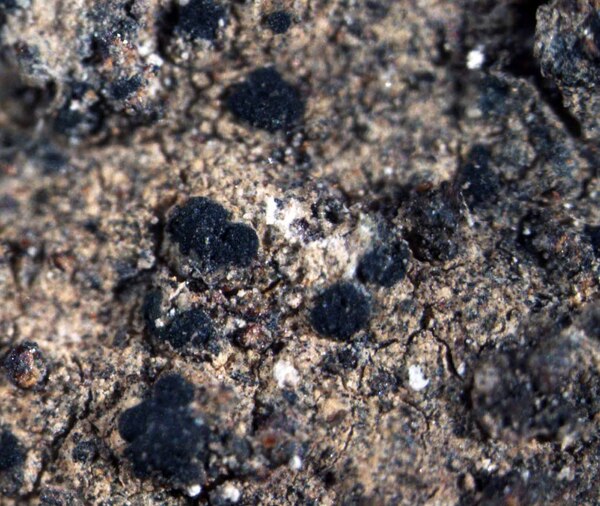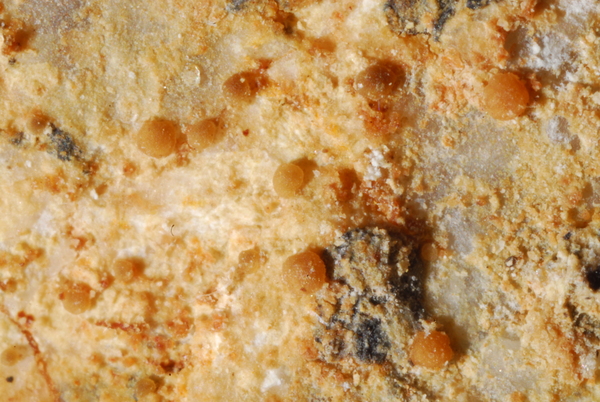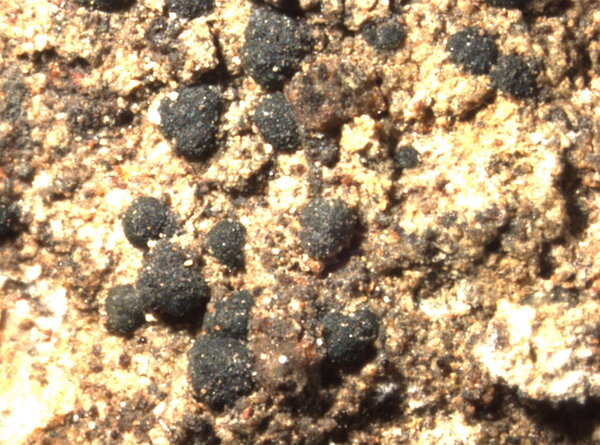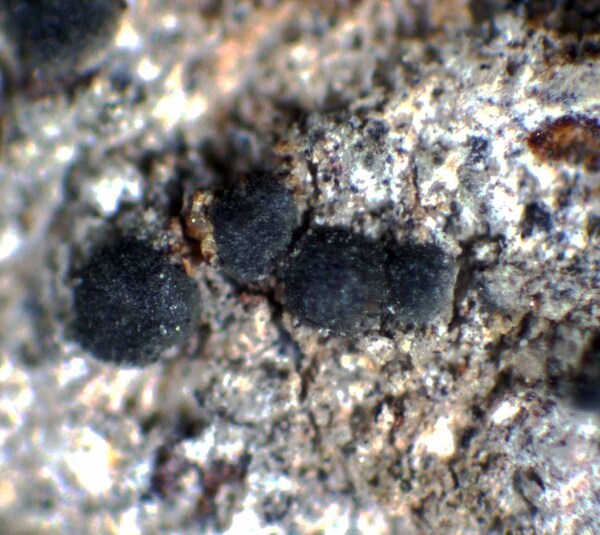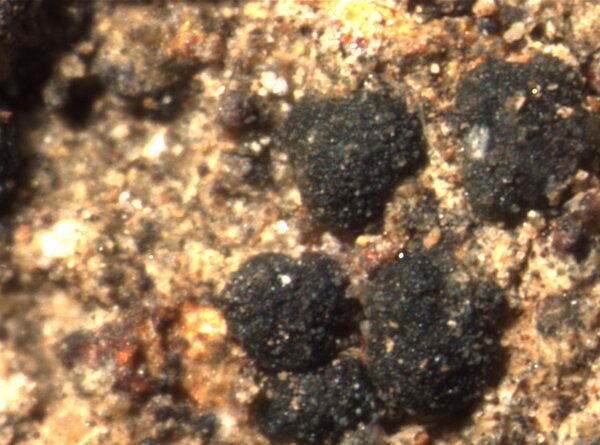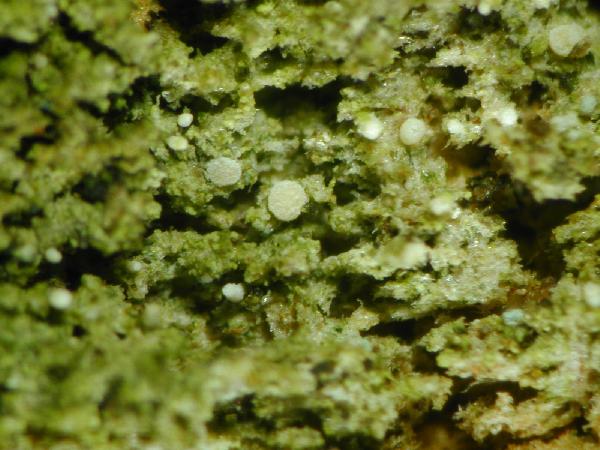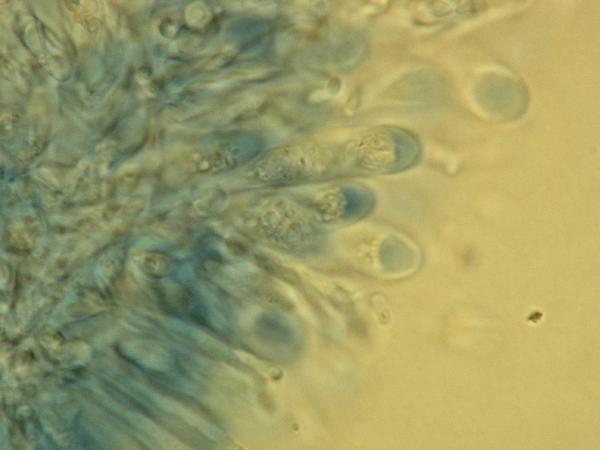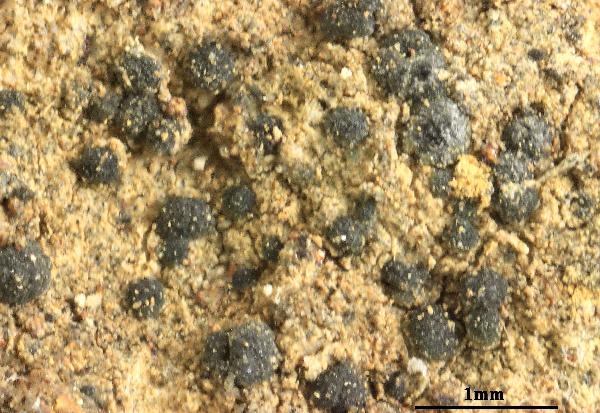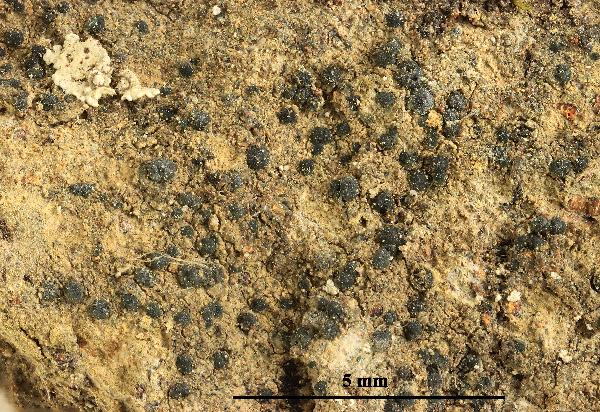Brianaria bauschiana (Körb.) S. Ekman & M. Svenss.
Lichenologist, 46: 292, 2014. Basionym: Biatora bauschiana Körb. - Parerga Lichenol.: 157, 1860.
Synonyms: Biatora rusticella (Nyl.) Walt. Watson; Biatora semipallens (Nyl.) Walt. Watson; Catillaria microspora Maslowa; Lecidea bauschiana (Körb.) Lettau; Lecidea dilutiuscula Nyl.; Lecidea infidula Nyl.; Lecidea lynceola Th. Fr.; Lecidea rusticella Nyl.; Lecidea semipallens Nyl.; Lecidea sylvicola var. infidula (Nyl.) Leight.; Micarea bauschiana (Körb.) V. Wirth & Vězda
Description: Thallus crustose, grey, grey-green, grey brown or sometimes rust-coloured, episubstratic, continuous, minutely cracked or granulose, sometimes quite thick and then forming distinctive, angular areolae in the middle part of the patches. Apothecia micareoid, sessile, not constricted at base, to 0.2-0.3(-0.5) mm across, sometimes confluent and forming up to 0.8 mm wide, tuberculate aggregates, with a convex-hemispherical, pale bluish grey to brown-black disc (brown in shade-forms), from the beginning without a distinct proper margin. Proper exciple absent; epithecium colourless or greenish, K-, N± red; hymenium colourless or greenish to pale blue-green in thick sections, (30-)40-70 μm high; paraphyses scarce, of two types: the majority sparingly branched and 0.5-1.2(-1.5) μm thick, the others mostly simple, often fasciculate and 1.5-2 μm thick; hypothecium colourless to pale greenish in upper part, of interwoven hyphae, K-. Asci 8-spored, cylindrical-clavate, the I+ blue tholus with a wide, I+ dark blue tube structure that expands towards the top, without a pale axial body, Psora-type. Ascospores 1-celled, hyaline, ellipsoid, thin-walled, (6-)7-11(-12) x (2-)3-4(-4.8) µm. Pycnidia to 0.1 mm across, immersed, the wall greenish, K- or K+ intensifying green, N+ reddish. Conidia bacilliform, 4-6(-7.5) x 0.8-1.2 μm. Photobiont chlorococcoid, the cells thin-walled, globose and (5-)7-12(-15) µm wide, or ellipsoid and up to 15 x 10 µm. Spot tests: K-, C-, KC-, P-, UV-. Chemistry: thallus without lichen substances.
Growth form: Crustose
Photobiont: green algae other than Trentepohlia
Reproductive strategy: mainly sexual
Most common in areas with a humid-warm climate (e.g. most of Tyrrenian Italy)
In underhangs rarely wetted by rain
Commonnes-rarity: (info)
Alpine belt: absent
Subalpine belt: absent
Montane belt: rare
Dry submediterranean belt: very rare
Humid submediterranean belt: absent
Padanian area: absent
pH of the substrata:
1 2 3 4 5
Solar irradiation:
1 2 3 4 5
Aridity:
1 2 3 4 5
Eutrophication:
1 2 3 4 5
Poleotolerance:
0 1 2 3
Altitudinal distribution:
1 2 3 4 5 6
Rarity
absent
extremely rare
very rare
rare
rather rare
rather common
common
very common
extremely common
Loading data...
Occurrence data
Predictive map
Growth form: Crustose
Photobiont: green algae other than Trentepohlia
Reproductive strategy: mainly sexual
Most common in areas with a humid-warm climate (e.g. most of Tyrrenian Italy)
In underhangs rarely wetted by rain
Commonnes-rarity: (info)
Alpine belt: absent
Subalpine belt: absent
Montane belt: rare
Dry submediterranean belt: very rare
Humid submediterranean belt: absent
Padanian area: absent
pH of the substrata:
| 1 | 2 | 3 | 4 | 5 |
Solar irradiation:
| 1 | 2 | 3 | 4 | 5 |
Aridity:
| 1 | 2 | 3 | 4 | 5 |
Eutrophication:
| 1 | 2 | 3 | 4 | 5 |
Poleotolerance:
| 0 | 1 | 2 | 3 |
Altitudinal distribution:
| 1 | 2 | 3 | 4 | 5 | 6 |
Rarity
absent
extremely rare
very rare
rare
rather rare
rather common
common
very common
extremely common
Loading data...
Occurrence data
Predictive map


